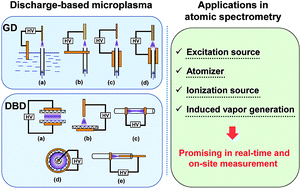当前位置:
X-MOL 学术
›
J. Anal. At. Spectrom.
›
论文详情
Our official English website, www.x-mol.net, welcomes your
feedback! (Note: you will need to create a separate account there.)
Advances in discharge-based microplasmas for the analysis of trace species by atomic spectrometry
Journal of Analytical Atomic Spectrometry ( IF 3.1 ) Pub Date : 2017-09-18 00:00:00 , DOI: 10.1039/c7ja00279c Shuang Liu 1, 2, 3, 4, 5 , Yong-Liang Yu 1, 2, 3, 4, 5 , Jian-Hua Wang 1, 2, 3, 4, 5
Journal of Analytical Atomic Spectrometry ( IF 3.1 ) Pub Date : 2017-09-18 00:00:00 , DOI: 10.1039/c7ja00279c Shuang Liu 1, 2, 3, 4, 5 , Yong-Liang Yu 1, 2, 3, 4, 5 , Jian-Hua Wang 1, 2, 3, 4, 5
Affiliation

|
Microplasmas have become an actual topic of interest for research in atomic spectrometric systems. Their excellent characteristics including low power consumption and small size and weight make the use of microplasmas a promising technique for developing portable analytical instrumentations for the real-time and on-site measurement of trace species. In this review, the current status of discharge-based microplasmas is presented and discussed from the viewpoint of four typical applications in the field of atomic spectrometry, i.e., excitation source, atomizer, ionization source, and induced vapor generation. Microplasma excitation sources are not only highlighted for the direct detection of trace species by optical emission spectrometry (OES), but also focused on for a series of coupling techniques with gas chromatograph (GC), microelectrodialysis (μED), capillary electrophoresis (CE), chemical vapor generation (CVG), and electrothermal vaporization (ETV). Besides the atomization function, microplasma atomizers could serve as a preconcentration device to achieve the trapping and release of analytes in atomizers. Microplasma ionization sources are used to ablate compounds from sample surfaces for analyte detection and profile analysis. Microplasma-induced vapor generation provides a novel sample introduction approach with the feature of being a green analytical method. The future prospects of microplasma application in the field of atomic spectrometry are also described.
中文翻译:

基于放电的微等离子体在原子光谱分析中的研究进展
微观等离子体已成为原子光谱系统研究中的一个实际感兴趣的话题。它们的优异特性(包括低功耗,体积小,重量轻)使微等离子体成为开发便携式分析仪器以进行痕量物种实时和现场测量的有前途的技术。在这篇综述中,是根据放电微等离子体的当前状态被呈现和从四种典型的应用的观点出发,在原子光谱法的领域中,所讨论的,即,激发源,雾化器,电离源和诱导的蒸气生成。微等离子体激发源不仅可以通过光发射光谱法(OES)直接检测痕量物质,而且还可以用于与气相色谱仪(GC),微电渗析(μED),毛细管电泳(CE),化学蒸汽产生(CVG)和电热汽化(ETV)。除雾化功能外,微等离子体雾化器还可以用作预浓缩装置,以实现雾化器中分析物的捕集和释放。微等离子体电离源用于消融样品表面的化合物,以进行分析物检测和轮廓分析。微等离子体诱导的蒸气产生提供了一种新颖的样品引入方法,具有绿色分析方法的特点。
更新日期:2017-11-02
中文翻译:

基于放电的微等离子体在原子光谱分析中的研究进展
微观等离子体已成为原子光谱系统研究中的一个实际感兴趣的话题。它们的优异特性(包括低功耗,体积小,重量轻)使微等离子体成为开发便携式分析仪器以进行痕量物种实时和现场测量的有前途的技术。在这篇综述中,是根据放电微等离子体的当前状态被呈现和从四种典型的应用的观点出发,在原子光谱法的领域中,所讨论的,即,激发源,雾化器,电离源和诱导的蒸气生成。微等离子体激发源不仅可以通过光发射光谱法(OES)直接检测痕量物质,而且还可以用于与气相色谱仪(GC),微电渗析(μED),毛细管电泳(CE),化学蒸汽产生(CVG)和电热汽化(ETV)。除雾化功能外,微等离子体雾化器还可以用作预浓缩装置,以实现雾化器中分析物的捕集和释放。微等离子体电离源用于消融样品表面的化合物,以进行分析物检测和轮廓分析。微等离子体诱导的蒸气产生提供了一种新颖的样品引入方法,具有绿色分析方法的特点。











































 京公网安备 11010802027423号
京公网安备 11010802027423号